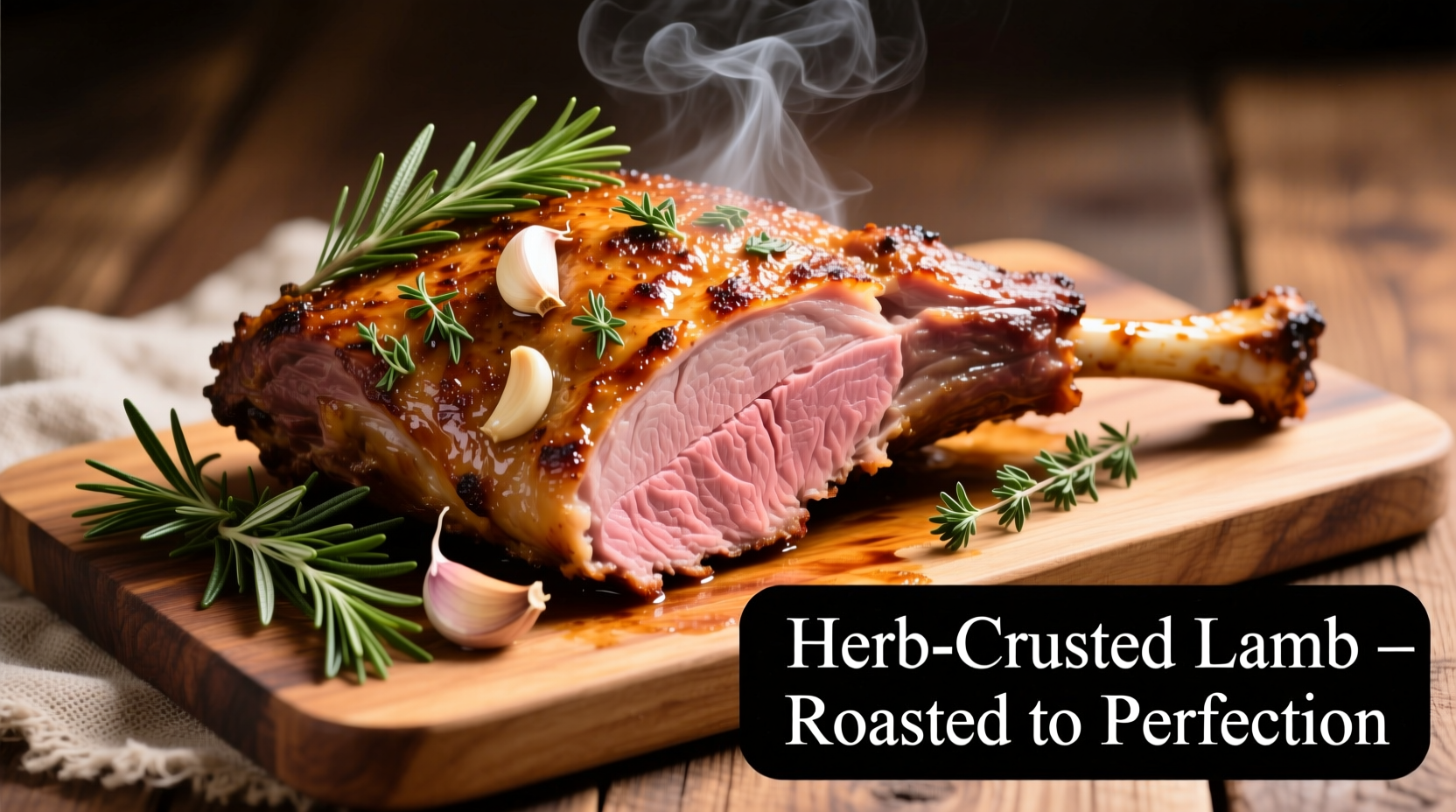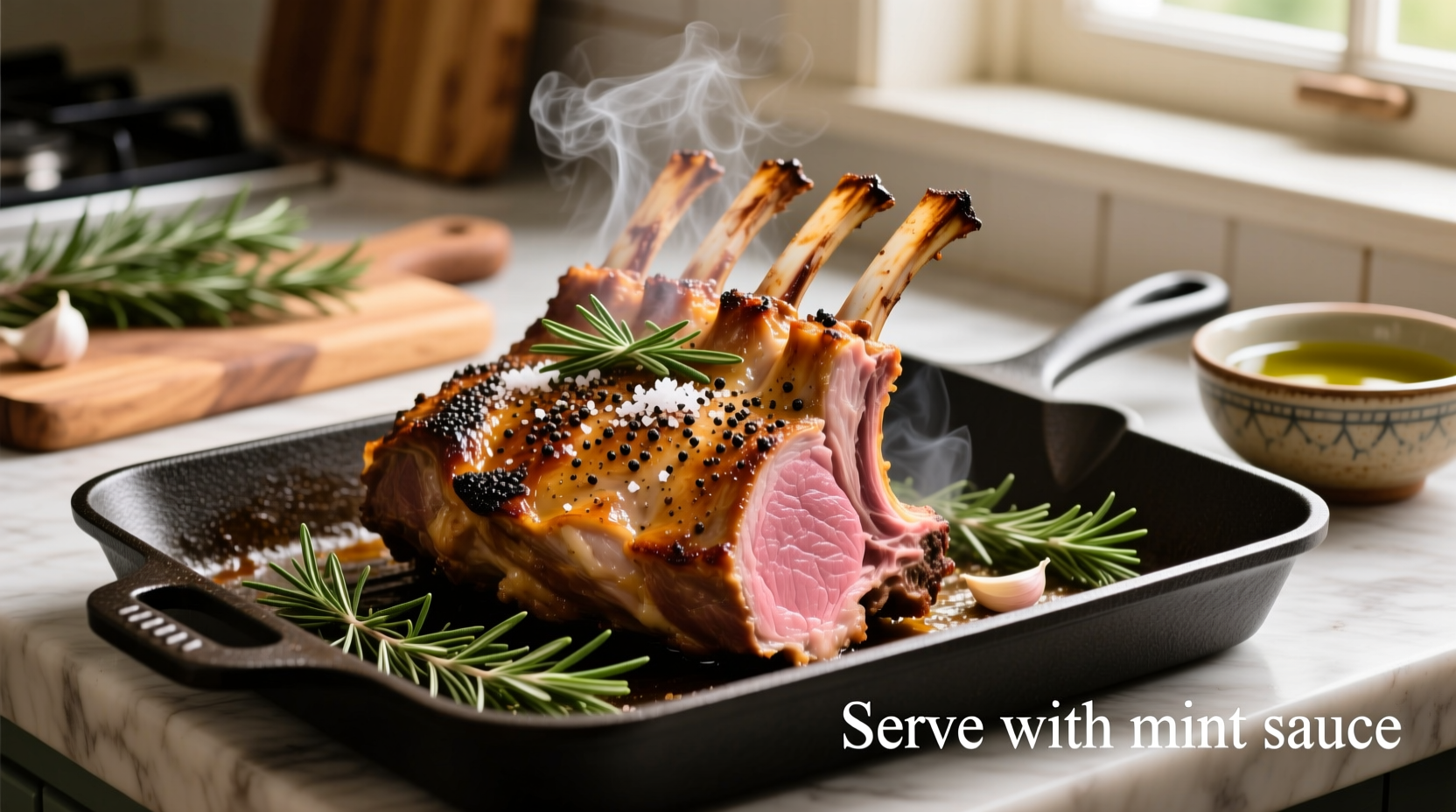Perfectly cooked oven-roasted lamb reaches an internal temperature of 130-135°F (54-57°C) for medium-rare, requiring 15-20 minutes per pound at 325°F (163°C) after a 20-minute sear at 450°F (232°C). Always rest for 15-20 minutes before carving to retain juices.
The Complete Guide to Oven-Roasted Lamb: From Selection to Serving
Nothing impresses guests or elevates a family dinner like a perfectly cooked leg of lamb. This comprehensive guide delivers exactly what home cooks need: precise timing, foolproof temperature control, and professional techniques that guarantee tender, flavorful results every time. Forget dry, overcooked lamb—master these methods and you'll consistently achieve restaurant-quality roasts with a beautiful crust and juicy interior.
Understanding Your Lamb Cut: Not All Roasts Are Created Equal
Before firing up your oven, identify your cut. Different lamb portions require specific approaches due to varying fat content, muscle structure, and connective tissue. Choosing the wrong method for your cut leads to disappointing results.
| Lamb Cut | Best Cooking Method | Approx. Time at 325°F | Ideal Internal Temp |
|---|---|---|---|
| Leg (bone-in) | High-heat sear + slow roast | 15-20 min/lb | 130-135°F (medium-rare) |
| Rack (Frenched) | Reverse sear method | 25-30 min total | 125-130°F (rare-medium) |
| Shoulder (boneless) | Low and slow roasting | 45-50 min/lb | 195°F (fork-tender) |
| Loin chops | Sear + finish in oven | 8-12 min total | 130°F (medium-rare) |
According to the USDA Food Safety and Inspection Service, lamb should reach a minimum internal temperature of 145°F for safety, but culinary professionals universally recommend lower temperatures for optimal texture and flavor retention in whole-muscle cuts like leg or rack. The key is proper resting time to allow carryover cooking.
Preparation: The Critical First Steps
Skip these preparation steps and you'll compromise your final result. Professional kitchens follow this exact sequence:
- Bring to room temperature: Remove lamb from refrigerator 1-2 hours before cooking. Cold meat cooks unevenly.
- Trim strategically: Remove large exterior fat pockets but leave a thin layer for flavor and moisture. Excess fat causes flare-ups.
- Score the fat cap: Make shallow diagonal cuts ½ inch apart to help render fat and allow seasoning penetration.
- Dry brine (optional but recommended): Rub with 1 tsp kosher salt per pound 24 hours before cooking for deeper seasoning.
For seasoning, the James Beard Foundation's culinary research shows that simple preparations outperform complex rubs for premium lamb. A classic combination of garlic, rosemary, thyme, salt, and black pepper enhances rather than masks the meat's natural flavor.
The Two-Phase Oven Method: Precision Roasting Technique
This professional technique delivers a perfect crust while maintaining precise internal doneness. It works for leg, rack, or loin cuts:
- Preheat oven to 450°F (232°C) with rack positioned in the center.
- Sear the lamb: Place on rack in roasting pan, fat-side down if applicable. Roast uncovered for 20 minutes to develop crust.
- Reduce heat to 325°F (163°C) without opening the oven door.
- Continue roasting until internal temperature reaches 120-125°F for medium-rare (use an instant-read thermometer in the thickest part, avoiding bone).
- Calculate timing: Plan for approximately 15-20 minutes per pound during the slow-roasting phase after the initial sear.

The American Meat Science Association confirms that this two-phase method optimizes the Maillard reaction (responsible for browning and flavor development) while minimizing moisture loss. The initial high heat creates complex flavor compounds, while the lower temperature ensures even cooking without overcooking the exterior.
Resting: The Non-Negotiable Final Step
Never skip resting—this is where your lamb transforms from good to exceptional. Here's why it matters:
- Internal temperature continues rising 5-10°F during resting (carryover cooking)
- Protein fibers relax, redistributing juices throughout the meat
- Surface moisture reabsorbs, maintaining crust integrity when carving
Cover loosely with foil and rest for 15-20 minutes (depending on size). For large roasts like a 6+ pound leg, rest for 20 minutes. Smaller cuts like racks need 15 minutes minimum. Cutting too soon releases precious juices onto your cutting board.
Troubleshooting Common Lamb Cooking Issues
Even experienced cooks encounter these problems. Here's how to fix them:
- Dry, overcooked lamb: Usually caused by exceeding 140°F internal temperature or insufficient resting. Solution: Cook to lower temperature (125-130°F) and rest properly.
- Uneven cooking: Often happens with irregularly shaped cuts. Solution: Position thicker areas toward oven back (typically hottest spot) and rotate pan halfway through cooking.
- Excessive smoke: Caused by fat dripping onto oven elements. Solution: Place a shallow pan of water on the oven rack below your lamb.
- Pale exterior: Indicates insufficient browning. Solution: Increase initial sear temperature or pat meat drier before roasting.
When Oven Roasting Isn't Your Best Option
While oven roasting works beautifully for most lamb cuts, certain situations call for alternative methods:
- Thin cuts under 1 inch thick: Better suited for pan-searing or broiling to prevent overcooking
- Shoulder or shank: Requires low-temperature braising (300°F for 3+ hours) to break down connective tissue
- Outdoor entertaining: Grilling provides superior flavor for chops and small racks
- Time constraints: For last-minute meals, reverse sear method (slow cook first, then high-heat sear) offers more timing flexibility
Remember that oven roasting shines when you have 1.5-3 hours to dedicate to the process and are working with substantial cuts like leg, rack, or loin. This method delivers consistent, hands-off cooking perfect for special occasions.
Serving and Pairing Suggestions
Elevate your roast lamb with these professional finishing touches:
- Carving technique: Slice against the grain at ¼-inch thickness for maximum tenderness
- Sauce pairing: Mint jelly remains classic, but a red wine reduction or garlic-herb gremolata adds sophistication
- Side dishes: Pair with roasted root vegetables, creamy mashed potatoes, or a crisp arugula salad
- Wine pairing: Cabernet Sauvignon or Syrah complement lamb's rich flavor profile
For special occasions, consider presenting the roast whole at the table before carving—a technique that impresses guests and showcases your culinary achievement.
Frequently Asked Questions
How do I know when lamb is done without a thermometer?
While a thermometer is recommended, you can use the touch test: press the meat with your finger. Rare feels like the base of your thumb when making a loose fist, medium-rare like the fleshy part below your thumb when touching index finger to thumb, and medium like when touching middle finger to thumb. However, this method requires practice and is less accurate than using a thermometer.
Should I cover lamb with foil while roasting?
Never cover during the initial high-heat sear as this creates steam and prevents proper browning. During the slow-roasting phase, only cover if the exterior is browning too quickly. For most standard ovens, uncovered roasting produces the best results. If using a convection oven, you may need to reduce temperature by 25°F to prevent over-browning.
Can I cook frozen lamb in the oven?
While possible, cooking frozen lamb significantly increases cooking time (approximately 50% longer) and often results in uneven cooking. For best results, thaw lamb completely in the refrigerator for 24-48 hours before roasting. If you must cook from frozen, increase initial sear time to 30 minutes and expect the slow-roasting phase to take 25-30 minutes per pound.
Why does my roasted lamb turn out dry?
Dry lamb typically results from overcooking beyond 140°F internal temperature or insufficient resting time. Lamb's delicate muscle fibers release moisture when exposed to high heat for too long. Always remove lamb from the oven at 125-130°F for medium-rare and allow proper resting time (15-20 minutes) for juices to redistribute before carving.
How long can I store leftover roasted lamb?
Store leftovers in an airtight container in the refrigerator for up to 3-4 days. For longer storage, freeze portions for up to 3 months. To reheat without drying, place in a covered dish with a splash of broth and warm slowly at 275°F until internal temperature reaches 130°F.











 浙公网安备
33010002000092号
浙公网安备
33010002000092号 浙B2-20120091-4
浙B2-20120091-4